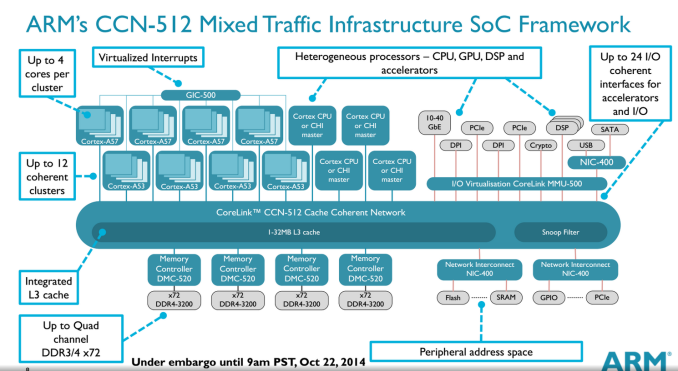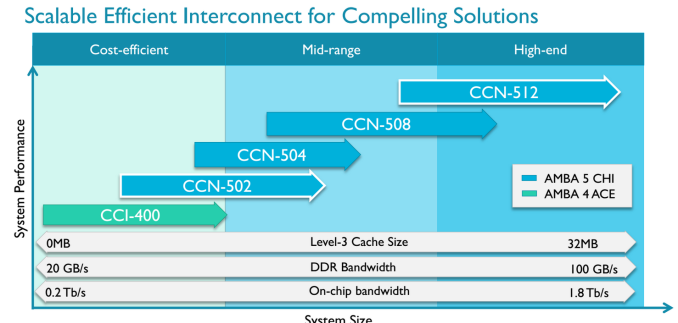ARM Challenging Intel in the Server Market: An Overview
by Johan De Gelas on December 16, 2014 10:00 AM ESTAMD Opteron A1100
The 28nm octal-core AMD Opteron A1100 is a lot more modest and aims at the low end Xeon E3s. Stephen has described the chip in more detail. To ensure a quick time to market, the AMD Opteron A1100 is made of existing building blocks already designed by ARM: the Cortex-A57 core and the Cache Coherent Network or CCN.
The AMD Opteron A1100 is one of the few vendors that uses the ARM interconnect. ARM put a lot of work into this design to enable ARM licensees to build SoCs with lots of accelerators and cores. CCN is thus a way of attaching all kinds of cores, processors, and co-processors ("accelerators") coherently to a fast crossbar, which also connects to four 64-bit memory controllers, integrated NICs, and L3 cache. CCN is very comparable to the ring bus found inside all Xeon processors beginning with "Sandy Bridge". The top model is the CCN-512 which supports up to 12 clusters of quad-cores. This could result in an SoC with 32 (8x4) A57 cores and four accelerators for example.
AMD would not tell us which CCN they are using but we suspect that it is CCN-504. The reason is this CCN was available around the time work started on the Opteron A1100 and the fact that AMD mentions the ARM bus architecture AMBA 5 in their slides. And it also makes sense: the CCN-504 supports up to 4 x 4 cores and supports the Cortex-A57.
It was rumored that the A1100 still used the CCI-400 interconnect, which is used by smartphone SoCs, but that interconnect uses the AMBA 4 architecture. Meanwhile the CCN-502 was announced in October 2014, way too late to be inside the A1100.
The AMD Opteron A1100 consists of four pairs of "standard" triple issue Cortex-A57 cores and 1MB L2 cache, with 8MB L3 cache.
The key differentiator is the cryptographic processor that can accelerate RSA (Secure Connection/hand shake) and AES (encrypting the data you send and receive) and SHA (part of the authentication). Intel uses the PCIe Quick Assist 89xx-SCC add-in card or the special Intel Communication chipset to provide a cryptographic coprocessor. These coprocessors are mostly used in professional firewalls/routers. As far as we know such cryptographic processors are of limited use in most https web services. Most modern x86 cores now support AES-NI, and these instructions are well supported. As a result, the current x86 CPUs from AMD and Intel outperform many co-processors when it comes to real world AES encoding/decoding of encrypted data streams.
A cryptographic coprocessor could still be useful for the RSA asymmetric encrypted handshake, but it remains to be seen if offloading the handshakes will really be faster than letting the CPU take care of it, as each offload operation causes all kinds of overhead (such as a system call). A cryptographic coprocessor running on the same coherent network as the main cores could be a lot more efficient than a PCIe device though. It has a lot of potential, but AMD could not give us much info on the current state of software support.














78 Comments
View All Comments
esterhasz - Thursday, December 18, 2014 - link
But this is exactly why a wider array of machines based on their chips would make sense: the R&D cost is already spent anyways, since iPhone and iPad need chips, selling more units thus reduces R&D cost per unit. Economies of scale.I don't believe a MBA variant with ARM is down the road either, but the rumored iPad Pro could develop into something similar rather quickly.
OreoCookie - Tuesday, December 16, 2014 - link
If you want to talk about ARM on the desktop, that's a whole other discussion, but one that most certainly needs to include price: if the price difference between a Broadwell-based Core M and a fictitious Apple A9X is $200~$230, then this changes the discussion completely. Two other factors are graphics performance (the Core M has »only« 1.3 billion transistors, the A8X ~2 billion, indicating that the mythical A9X may have faster graphics) and the fact that Apple controls the release schedule and can spec the SoC to meet its projected needs. To view this topic solely through the lens of CPU performance is myopic.darkich - Friday, December 19, 2014 - link
Your comparisons missed the picture spectacularly.A8X is a 20nm 2-4W TDP chip with a price that is probably around 70$.
Top of the line Core M5Y70 is a 14nm 4.5 W TDP chip with a price of 270$.
And it has a weaker GPU, btw. (raw performance). And it throttles massively, effectively giving only 50% of the benchmark performance.
If you're going to compare that to an Apple chip, compare it to a 14nm A9X with custom derived PowerVR series 7 GPU,(scales up to 1,4 TFLOPS) vastly expanded memory controllers connected to a much faster RAM (compared to one in the iPad) upclocked to 2GHz, that are available at any time.
darkich - Friday, December 19, 2014 - link
.. *with cores upclocked to about 2GHzFlunk - Tuesday, December 16, 2014 - link
Nintendo already sells ARM systems, the 3DS and the DS before it are both ARM-based. The PSVita is ARM too. I don't see an ARM Macbook Air anytime soon, they need a bigger and higher-clocking chip for that and it doesn't look like that's going to happen anytime soon.Nintendo Maniac 64 - Tuesday, December 16, 2014 - link
Even the Game Boy Advance used an ARM7 for its main CPU.jjj - Tuesday, December 16, 2014 - link
Obviously there are handhelds using ARM but the point was about bigger cores and clearly not handhelds.DLoweinc - Tuesday, December 16, 2014 - link
Don't quote Wikipedia, not suitable for this level of writing.garbagedisposal - Tuesday, December 16, 2014 - link
Says DLoweinc, master of knowledge and scholarly writing.In contrast to your childish and outdated opinion, Wikipedia is a perfectly valid source of information, go read about it and quit crying.
Daniel Egger - Tuesday, December 16, 2014 - link
The problem really is the custom solutions can simply not compete with Intel on any level for general purpose computing (which the majority of applications are), not on performace/price, performance/power and not even on features/price.For instance I can see a huge market for sub-Xeon (or Atom C) performance at a corresponding price -> not going to happen because everyone is targeting > Xeon performance at ridiculous prices because they're expecting the margin to be there however there're simply to many compromises to be made by the buyers so that has to fail.
Also I can see a huge demand for Atom C - Xeon performance at lower power consumption however no one seems to be really targetting this, all we get are Raspberry Pi's and a bit beefier but close from even Atom C. The new virtualisation techniques (Docker et al) opened a whole new can of possibilities for non-x86(_64) devices because virtualisation is suddenly possible and much more lightweight than ever before but no one seems to want to jump this opportunity.
I'd really like to buy some affordable general purpose (BYOM/BYOS) hardware which has a little bit of oomph and takes little power which should be the powerful sides of any of the contenders but somehow all fail to deliver and I don't even see an attempt to change that.
If I want mind-boggling performance at decent performance/price ratio with real virtualisation and 100% standard software compatibility there's no way around the high end Xeons (and maybe AMD iff they manage to get their asses back up) and none of the contenders is ever going to challenge that so they might as well stop trying.